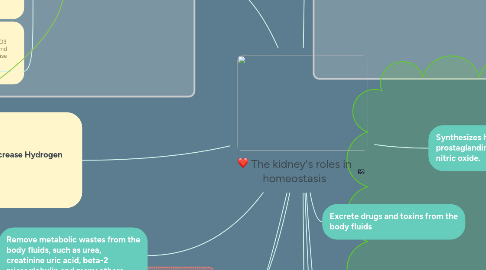
1. RISE in Plasma pH = Decrease Hydrogen Ion
1.1. The kidney reduces the amount of hydrogen ion secretion ---> results in reduction in the plasma bicarbonate level.
1.1.1. The plasma bicarbonate corrected by a reduction in ventilation rate by the lungs--> build up of CO2 which drives the reaction sequence to the Right to generate more bicarbonate ions.
1.1.1.1. Increase Plasma pH
2. Regulates acid base balance of body fluids in conjunction with body buffer systems and the respiratory system
2.1. H20+ CO2---> H2CO3--> HCO3+H
2.1.1. 1. The Filtered Bicarbonate ion undergoes a reaction sequence to produce water and carbon dioxide
2.1.2. 2. The water and carbon dioxide molecules diffuse into the proximal tubule cell and undergo the same reaction sequence in reverse to reform the bicarbonate ion. The resulting hydrogen ion is secreted back into the lumen
2.1.3. 3. The bicarbonate ion diffuses into the blood.
2.2. The increases of pH ---> Drive the HCO3 sequence to the left to produce CO2 and water. ---> FALL IN PLASMA pH increase hydrogen ion.
3. Remove metabolic wastes from the body fluids, such as urea, creatinine uric acid, beta-2 microglobulin and many others.
4. Regulate blood pressure
4.1. Blood Pressure
4.1.1. Renin in kidney release
4.1.1.1. Angiotensin 1
4.1.1.1.1. ACE
5. Perform gluconeogenesis (in fasting state)
6. Erythropoietin production in the Kidney is stimulated by Hypoxia is corrected. Erythropoietin is a glycoprotein that promotes the proliferation and differentiation of erythrocytes precursors on the bone marrow making them essential in the maintenance of a normal cell counts
7. Regulates body fluid volume and osmolality
7.1. Antidiuretic hormones (ADH)
7.1.1. 1. Change in Plasma Osmolality
7.1.2. 2. Hypothalamus -> Dtects small changes in the plasma osmolality.
7.1.3. 3.Posterior pituitary -> secrets ADH
7.1.3.1. Osmolality = increase of ADH
7.1.3.2. Osmolality = decrease of ADH
7.2. Aldosterone
7.2.1. Via RAAS system , Aldosterone stimulation In kidney, more potassium and water return to kidneys, more potassium eliminated in urine
7.3. Atrial Natriuretic Peptide
7.3.1. Inhibition of aldosterone by the adrenal cortex
7.3.2. Reduction of Renin release by the Kidney
7.3.3. Reduction of ADH release from the Posterior pituitary Gland
7.3.4. Vasodilation
7.3.5. Natriuresis and Diuresis
7.3.6. Results in the Excretion of Sodium and water through the kidneys reducing the extracellular fluid back to normal.
8. Regulates electrolyte balance of body fluids
8.1. Sodium
8.1.1. Decrease Na
8.1.1.1. ALDOSTERONE via RAAS system increases Na and water retention.
8.2. Potassium
8.2.1. Increase Potassium levels
8.2.1.1. Stimulates ALDOSTERONES secretion
8.2.2. Drecrease Aldosterone
8.2.2.1. Reverse occurs and less potassium is secreted into the urine
8.3. Calcium
8.3.1. 1. Decrease calcium is detected by cells of the parathyroid hormone (PTH) which circulated in the blood.
8.3.2. 2. ParathyroidGlands increase of parathyroid hormone (PTH) which circulated in the blood.
8.3.3. 3. PTH binds to the receptors on the distal tubules and on the bones
8.3.4. 4. Kidneys-> Increase reabsorption and Decrease phosphate reabsorption. Activation of Vitamin D to increase absorption of Calcium-> Bone -> increase bone reabsorption
